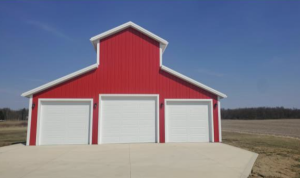Welcome to Ask the Pole Barn Guru – where you can ask questions about building topics, with answers posted on Mondays. With many questions to answer, please be patient to watch for yours to come up on a future Monday segment. If you want a quick answer, please be sure to answer with a “reply-able” email address.
Email all questions to: PoleBarnGuru@HansenPoleBuildings.com
DEAR POLE BARN GURU: I want to insulate my already constructed pole building that has 10′ center uprights 8.6 in between uprights 16′ sheathed ceiling’s uprights are 5.5″ diameter what’s the best most cost effective way to go about it. MARK IN CAMBRIDGE
DEAR MARK: I’m going to have to do some guessing as the math doesn’t quite work out. If your “uprights” are on ten foot centers then the space between the columns will be 9’6”. If the space between is 8’6” then your columns are nine foot on center.
Ceiling will be easy – as long as you have a thermal break (e.g. reflective radiant barrier or similar) insulation can be blown directly on top of the ceiling. If no thermal break has been provided, then a layer of spray foam insulation should be applied to the underside of the roof steel.
Adequate attic ventilation will need to be provided – read more about it here: https://www.hansenpolebuildings.com/2014/02/pole-building-ventilation/
For the walls, the first step – remove the wall steel, one wall at a time. Install a good quality building wrap (https://www.hansenpolebuildings.com/2012/11/house-wrap/).
How the inside is handled will be based upon the materials being used on the inside of the wall. For materials which will not crack (steel liner panels, OSB, or plywood) 2×4 wall girts can be added to the inside of the columns “barn style”.
For sheetrock, things get a little more dicey, as the original design of the building should be checked by a RDP (Registered Design Professional – engineer or architect) to verify the building is stiff enough to keep deflection within allowable limits. Provided the building is adequately stiff, 2×4 or 2×6 wall girts can be added “bookshelf” style (https://www.hansenpolebuildings.com/2011/09/commercial-girts-what-are-they/).
Once any electrical work has been completed in the walls, unfaced batt or BIBs (https://www.hansenpolebuildings.com/2011/11/bibs/) can be added to the wall assembly. A well-sealed vapor barrier needs to be placed on the inside of the wall insulation https://www.hansenpolebuildings.com/2013/07/moisture-barrier/.
DEAR POLE BARN GURU: Have you ever tried using stands under your posts before you pour. I like the concept brand “X” uses, just seems a little overly complicated.
Thanks. SCOTT IN MACOMB
DEAR SCOTT: Without knowing who Brand “X” is, hard for me to comment on their methodology. I have not personally tried the use of stands, however I have written about them: https://www.hansenpolebuildings.com/blog/2014/05/one-pour-reinforcement-cage/.
This does seem like a costly method, when it is actually quite simple to just ‘float’ the posts in the holes: https://www.hansenpolebuildings.com/blog/2015/04/floating-poles/
Mike the Pole Barn Guru
DEAR POLE BARN GURU: Can a pole barn be designed for a crawl space instead of a concrete slab? SUSAN IN OPELIKA
DEAR SUSAN: Most certainly. As we are seeing more and more people gravitating to pole barn (post frame) technology for dwellings, we are designing more homes over both crawl spaces and full basements. We design pole buildings for folks with crawl spaces quite frequently. You can read more about pole barn crawl spaces at: https://www.hansenpolebuildings.com/2013/03/crawl-space/. Or, if a crawl space isn’t enough, a basement: https://www.hansenpolebuildings.com/2013/04/basement/.
Mike the Pole Barn Guru
DEAR POLE BARN GURU: I have been planning a 24 x 48 x 10 three sided barn as it fits my needs for equipment storage and heat build-up and natural light. I read your blog on 3 sided barn vs. wind. My barn would be enclosed on the long north wall and the short east and west if I left open the east wall would that be enough to alleviate the wind pressure concern.
Thanks. BUDD IN MARIANNA
DEAR BUDD: From reading my article on three sided buildings (https://www.hansenpolebuildings.com/blog/2014/03/three-sided-building/), you have found out it may not be the most economical design solution.
Ideally, you would be able to construct a four sided building. The three sided design works fine structurally, as long as it is properly designed to resist the added loads. If you leave a long side and a portion of one of the other walls open, then you could reduce the wind pressures. In any case, I would recommend you seek out the services of a firm such as Hansen Pole Buildings – who can arrive at a solution which is structurally sound and best meets your needs.
Mike the Pole Barn Guru
 Now picture a pole building with one of the walls open – when the wind blows, the inside pressure is increased, causing the building to want to expand (which is not a good thing).
Now picture a pole building with one of the walls open – when the wind blows, the inside pressure is increased, causing the building to want to expand (which is not a good thing).





